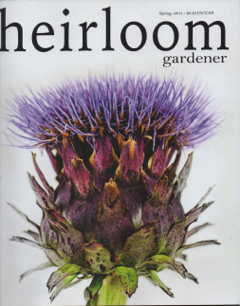 Spring, 2015
Spring, 2015At twilight, the silver, ethereal glow from an artichoke plant draws the eye to its fountain of regal, deeply, cut leaves. The plant, which can get to four feet in height and span five feet or more, is a dominant focus of the garden. The harvested buds yield meaty, bottomed petals perfect for dipping. The hearts, with a natural, savory, sweetness, lend themselves to pickling, pasta dishes, salads, sauces for seafood and chicken. When left to bloom the buds become dramatic show-stopping purple blossoms atop the grand spread of its gray-green, frosted leaves and stalwart stem.
Artichokes, cardoons and thistles are all related. The cardoon and artichoke have been cultivated for culinary uses since Roman times. They can be grown successfully in a wide variety of climates. Taking care to select the proper type of plant and attend to its cultural needs.
HEIRLOOM ARTICHOKES
Green Globe
A favorite of Thomas Jefferson at Monticello, needing a fairly long, mild growing season.
Violette de Provence
Rare outside of Europe, this French heirloom has tasty pretty, purple buds.
Violetta Precoce
Deep, purple artichokes are more tender than green artichokes. This one has prickly, purple buds, is popular in Italy and needs a warmer season.
Purple of Romagna
Bountiful producer of smaller chokes in rich purple violet shades.
HEIRLOOM CARDOONS
Rouge d’Alger Cardoon
An Algerian heirloom with big and ornamental edible stalks blushed red, which contrasts with the blue-green leaves. The buds of this historic variety can be cooked and eaten like artichokes. Or allow them to bloom for beautiful, ornamental, lavender flowers.
Gobbo Di Nizzia Cardoon
A rare cardoon from Italy, its broad white stalks are eaten fried, sautéed, pickled, in soups, or eaten raw, dipped in olive oil with balsamic vinegar. The root is also edible, tasty, and can be used like parsnips.
NUTRITION
Artichokes are excellent sources of fiber, vitamin C and antioxidants. Folate, vitamin K, potassium, and magnesium are present in generous amounts. They’re also very low in saturated fat and cholesterol, a good source of niacin, B6, iron, phosphorus and copper. Modern health & wellness studies are supporting the artichokes allure . Most studies show some preventative, curative or nutritive properties.
Their qualities have proven remedial effects on the liver and are used to stimulate and aid digestion. Cynar, is an Italian artichoke based aperitif drunk before meals to spark the appetite. Artichoke rusks are given to teething babies. A number of digestive tonics, in over the counter medicines, contain artichokes as an ingredient.
RECIPES
To steam artichokes in a way to enhance their innate flavor:
In a pan, place in the water beneath the steamer, 1 Bay leaf, 2 garlic cloves quartered, 3 clove buds. Place in steamer basket 4 chokes with the top of the flower down and the stem end up. Steam for 20 – 30 minutes. When knife is poked into the stem and it is soft, chokes are done.
LOW-FAT ARTICHOKE DIP
½ Cup non-fat yogurt
½ Cup low fat mayonnaise
2 garlics crushed through press
1-Tablespoon Worcestershire Sauce
Blend all to smooth consistency. Makes 1 Cup.
TURKEY, ARTICHOKE HEART PANINI
3/4 cup pitted Kalamata olives
2 tablespoons olive oil
2 garlic cloves
1 teaspoon lemon zest
1/4 cup mayonnaise
2 Cups chopped turkey
1 (12-ounce) jar marinated artichokes, drained and coarsely chopped
1-teaspoon fresh lemon juice
1/2 teaspoon freshly ground black pepper
8 slices artisanal bread
1 tomato, seeded, diced
Puree the olives, oil, garlic, and zest in a food processor until smooth and spreadable. Blend in the mayonnaise. Toss the tuna, artichokes, lemon juice, and pepper in a medium bowl, keeping the tuna in small chunks. Spread the olive puree over two slices of the bread. Spoon the tuna and artichoke mixture onto the bottom half of the bread. Sprinkle the tomatoes over. Cover with the bread top and put in Panini press. Cut in half. Serves four
ARTICHOKE HEART PASTA SAUCE
2(14-ounce) can artichoke hearts
6 Tablespoon olive oil
5 cloves garlic
1 (15-ounce) can kidney beans
1 lemon, juiced
½ cup chopped parsley
1 cup grated Asiago cheese
1-teaspoon chili flakes
Cooked pasta of choice
Place the artichoke hearts, olive oil and garlic in blender, blend until smooth. Heat in a saucepan until bubbling. Drain kidney beans. Pour sauce over pasta, sprinkle kidney beans liberally over sauce. Sprinkle lemon juice over all. Top with chopped parsley and Asiago to taste. Lastly sprinkle chili flakes. Makes 4 servings.
GROWING TIPS
Relatives of the artichoke, Cynara scolymus, grow wild in the Mediterranean areas of Southern France and Italy, Greece, and Spain. The Romans developed early culinary uses for this descendant of the thistle. Although their ancestors were weeds, artichokes now require richer soils, so it’s important to amend the planting area with 2 – 3 inches of compost and a gallon of composted manure. Work the amendments into the top ten inches of soil before planting and include a generous portion of dolomite lime for calcium.
Calcium is important for developing sweetness in plants. Strawberries and fruit trees benefit from this mineral as well. Artichokes can handle alkaline soil conditions more than most vegetables. The best pH is 6.5 – 7.0. Give the plants lots of room, 3 feet on average, if you want a good yield. Keep them constantly moist and mulched.
Seeds have a long germination period, 10 – 20 days. But vernalization can get you flower heads the first year, otherwise, it takes two years to develop generously budded plants. Vernalization is a technique where the artichoke seed is held below freezing for 10 to 15 days, then planted. Established transplants can also be set out for a few weeks when the frost date is just past, in 45 to 50 degree weather, and permanently planted when the weather gets warmer. It fools this biannual plant into thinking it just experienced it’s first winter, so the flower buds need to come out. Start them in January or February.
In zones 7 and higher the plants can be cut in August to one foot off the ground. Fall can produce more stems with buds. In October cut down to the ground and mulch the root with straw or leaves to insure the root from potential freezes. Some varieties will over winter and bear up to six years, from the offshoots of the root.
Remembering to keep them watered, mulched and composted will yield many large buds with smaller side buds. Similar to the way broccoli has one central large head and smaller off shoots, which are even more tender than the central head. A delight of the smaller artichoke bud is the softer choke, which can be eaten with as much pleasure as the heart.
Grow this giant fountain of the garden for it’s dramatic contribution of beauty and nutrition. Join the generations of gardeners through the centuries enjoying this lush plant with its buds of bliss.
SOURCES FOR SEEDS, INFORMATION, AND PLANTS
Baker Creek Rare Seeds
Edible Landscaping by Rosalind Creasy
Four Season Harvest by Elliot Coleman
Encyclopedia of Herbs and Herbalism by Malcolm Stuart
American Journal of Clinical Nutrition (2006) study data
USDA Nutrition Data Center



